NavSource Online: Submarine Photo Archive
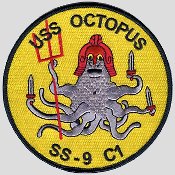
Patch contributed by
Don McGrogan, BMCS, USN (Retired)
Please report any broken links or trouble you might come across to the Webmaster.
Please take a moment to let us know so that we can correct any problems and make your visit as enjoyable and as informative as possible.

![]()
![]()
![]()
| Click On Image For Full Size | Size | Image Description | Source | |
|---|---|---|---|---|
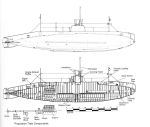 | 95k | The Octopus class was the first designed entirely by L.Y. Spear (Holland had left Electric Boat). As in the Viper design, the periscope was a fixed-eyepiece type let into the conning tower. Note the scope directly under the engine to collect cooling water; until the 1930s, U.S. submarines engines used seawater as a coolant. The high speed diesels introduced at that time used closed circuit cooling, in which fresh water circulated around the cylinders and surrendered its heat to a heat exchanger (radiator) in contact with the sea. This design introduced E.B.'s characteristic stern, with two propeller shafts nearly parallel to the axis of the hull, rudders and stern planes arranged symmetrically around that axis, and heavy skegs protecting and supporting planes and rudders. This was also the first class of U.S. subs completed with a bell for underwater signaling (it was later fitted to earlier boats). Air-operated signal bells were superseded in later designs by electrically operated Fessenden oscillators, which could put out stronger signals. | Drawing by Jim Christley. Photo & text courtesy of U.S. Submarines Through 1945, An Illustrated Design History by Norman Friedman. Naval Institute Press. |
|
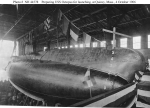 | 95k | Octopus (SS-9) being prepared for launching, at the Fore River Ship Building Company shipyard, Quincy, Massachusetts, 4 October 1906. | Courtesy of the U.S. Naval Historical Center, Photograph # NH 44578. | |
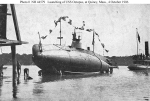 | 95k | Halftone reproduction of a photograph taken during launching of the Octopus (SS-9) at the Fore River Ship Building Company shipyard, Quincy, Massachusetts, 4 October 1906. | Courtesy of the U.S. Naval Historical Center, Photograph # NH 44579. | |
 |
806k | THE OCTOPUS (SS-9). Largest submarine ever built for the United States Navy. She will compete in the Newport tests this week. | Image and text provided by Library of Congress, Washington, DC. Photo from New-York Tribune. (New York [N.Y.] 1866-1924, 28 April 1907, Image 52, via chroniclingamerica.loc.gov. |
|
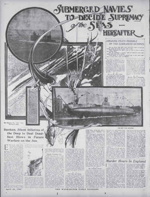 |
767k | THE NEW TYPE OCTOPUS (SS-9). | Image and text provided by Library of Congress, Washington, DC. Photo from The Washington Times. (Washington [D.C.] 1902-1939, 28 April 1907, Magazine Section, Image 46, via chroniclingamerica.loc.gov. |
|
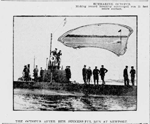 |
1.01k | SUBMARINE OCTOPUS (SS-9). Making record breaking submerged run 15 feet below surface. | Image and text provided by Library of Congress, Washington, DC. Photo from New-York Tribune. (New York [N.Y.] 1866-1924, 10 May 1907, Image 8, via chroniclingamerica.loc.gov. |
|
 | 1.02k | Octopus (SS-9) surfacing after a submerged run, during her preliminary trials, off Newport, Rhode Island, July 1907. | Courtesy of the U.S. Naval Historical Center, Photograph # NH 44576. | |
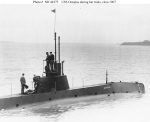 | 57k | Octopus (SS-9) photographed during trials, circa 1907. | Courtesy of the U.S. Naval Historical Center, Photograph # NH 44577. | |
 | 81k | Photograph taken circa 1907, when Octopus (SS-9) was first completed. It was published on a color-tinted postal card by Thomson & Thomson, Boston, Massachusetts, prior to World War I. | Courtesy of Commander Donald J. Robinson, USN (Retired), 1978. Courtesy of the U.S. Naval Historical Center, Photograph # NH 88481. | |
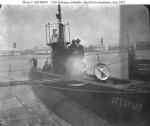 | 74k | Octopus (SS-9) in port, probably when first completed, circa 1907. | Courtesy of the U.S. Naval Historical Center, Photograph # NH 98945. | |
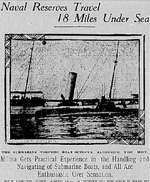 |
1.39k | Naval Reserves Travel 18 Miles Under Sea THE SUBMARINE TORPEDO BOAT OCTOPUS (SS-9) Militia Gets Practical Experience in the Handling and Navigating of Submarine Boats, and All Are Enthusiastic Over Sensation. | Image and text provided by Library of Virginia; Richmond, VA. Photo from The Times Dispatch. (Richmond, Va.) 1903-1914, 12 August 1908, Image 8, via chroniclingamerica.loc.gov. | |
 |
NR | SUBMARINES FOR THE PACIFIC | Image and text provided by Washington State Library; Olympia, WA. Photo from Aberdeen Herald. (Aberdeen, Chehalis County, W.T.) 1886-1917, 09 November 1908, Image 7, via chroniclingamerica.loc.gov. | |
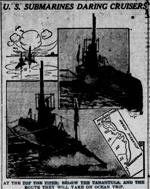 | NR | U. S. SUBMARINES DARING CRUISERS AT THE TOP THE VIPER (SS-10); BELOW THE TARANTULA AND THE ROUTE THEY WILL TAKE ON OCEAN TRIP. An adventure watched with interest by the navy officials and by thousands throughout the country is the cruise of four submarines from Philadelphia to Charleston, S. C. The boats are the Tarantula, Viper, Cuttlefish (SS-11) and Octopus (SS-9). | Image and text provided by Washington State Library; Olympia, WA. Photo from The Spokane Press. (Spokane, Wash.) 1902-1939, 12 November 1908, Image 7, via chroniclingamerica.loc.gov. |
|
 | 459k | Tender Severn with 4 C-boats & dinghies alongside, circa 1911. | Photo i.d. courtesy of Ric Hedman. USN photo courtesy of Tommy Trampp. |
|
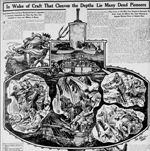 |
1.33k | In Wake of Craft That Cleaves the Depths Lie Many Dead Pioneers Experiments That Led Up to Wonderful Feat of a Squadron of American Submarines the Other Day Have Cost Hundreds of Lives and Millions of Money. | Embedded text courtesy of U.S. Submarines Through 1945, An Illustrated Design History by Norman Friedman. Naval Institute Press. PDF Image and text provided by Library of Congress, Washington, DC. Photo from New-York Tribune. (New York [N.Y.] 1866-1924, 2 July 1911, Image 17, via chroniclingamerica.loc.gov. | |
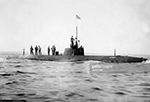 |
674k | Octopus (SS-9) - probably in the 1910s. | Photo by Haeckel collection/ullstein bild via Getty Images, courtesy of gettyimages.com. | |
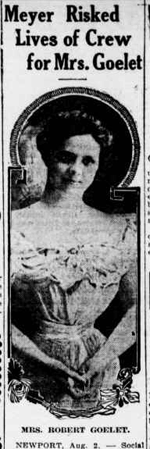 |
1.15k | Meyer Risked Lives of Crew for Mrs. Goelet. | Image and text provided by Washington State Library; Olympia, WA. & Library of Congress, Washington, DC. Photo from The Tacoma Times. (Tacoma, Wash.) 1903-1949, 02 August 1911, Image 7, & New-York Tribune (New York [N.Y.] 1866-1924, 27 July 1911, Image 1 via chroniclingamerica.loc.gov. |
|
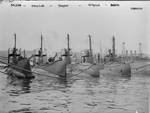 | 136k | The Salmon (SS-19),Grayling (SS-18), Tarpon (SS-14), Octopus (SS-9), Bonita (SS-15) with the battleship Nebraska (BB-14) in the background on 28 October 1911. | Digital ID # 2162989549_03ac37e6c6_o, LC-B2-2335-13. Source: Library of Congress Prints and Photographs Division, from the George Grantham Bain Collection, courtesy of Tom Kermen. | |
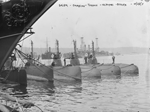 | 136k | Bow of the tender Severn and her charges: Salmon (SS-19),Grayling (SS-18), Tarpon (SS-14), Octopus (SS-9), Bonita (SS-15) with the battleship Nebraska (BB-14) in the background on 28 October 1911. | Digital ID # 2163790702_9293e5e616_o. Source: Library of Congress Prints and Photographs Division, from the George Grantham Bain Collection, courtesy of Tom Kermen. | |
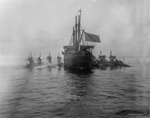 |
2.19k | Submarines and their tender The time frame is circa pre-November 1911. Location is possibly New York Harbor. The picture shows the Severn with 4 of the C class submarines lying along her port side, Tarpon (SS-14), Octopus (SS-9), Bonita (SS-15), and Stingray (SS-13) and what are most likely all the D class (in no particular order) on her starboard side: Narwhal (SS-17), Grayling (SS-18) & Salmon (SS-19). | Photo i.d. & text courtesy of Ric Hedman. Photo from loc.gov | |
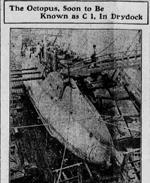 |
648k | The Octopus (SS-9), Soon to Be Known as C-1, In Drydock When she emerges from her berth in drydock at the New York navy yard, the submarine Octopus will be the C-1. This is in pursuance the new policy of the vessels of this class by letter and number instead of by names of fishes as has generally been done in the navy. In making the change the navy department is following the practice of the British and French, and perhaps anticipating the time when the United States shall have built so many submarines that all the commonly known denizens of the deep would not suffice for the naming of them. | Image and text provided by Ohio Historical Society, Columbus, OH. Photo from The Democratic Banner. (Mt. Vernon, Ohio) 1898-192?, 23 January 1912, Image 1, via chroniclingamerica.loc.gov. | |
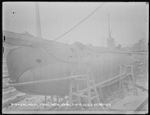 |
289k | Octopus (SS-9) at N.Y.N.Y., 6 February 1912. | National Archives Identifier: 6126670 Local Identifier:F1046 N1 Photo courtesy of catalog.archives.gov | |
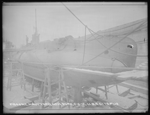 |
294k | Octopus (SS-9) at N.Y.N.Y., 6 February 1912. | National Archives Identifier: 6126671 Local Identifier:F1046 N2 Photo courtesy of catalog.archives.gov | |
 |
492k | Octopus (SS-9) at N.Y.N.Y., 6 February 1912. | National Archives Identifier: 6126672 Local Identifier:F1046 N3 Photo courtesy of catalog.archives.gov | |
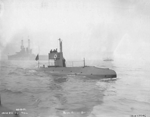 | 340k | C-1 (SS-9), during the Naval Review week in New York City, 4th October 1912. The battleship Kearsarge (BB-5) is in the background. | NARA (National Archives and Record Administration) photo # 19-N-13646, courtesy of Daniel Dunham & fixed by Jim Kelling. | |
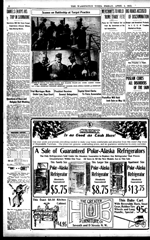 | 1.20k | DANIELS ENJOYS HIS TRIP IN SUBMARINE | Image and text provided by Library of Congress, Washington, DC. Photo from The Washington Times., 1902-1939, 4 April 1913, Last Edition, Image 2, via chroniclingamerica.loc.gov. | |
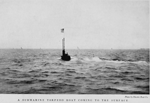 0801818d |
710k | A C or D-class boat diving, not surfacing, in spite of what the caption says, circa 1913. | Photo & text i.d. courtesy of Dave Johnston. Photos courtesy of Sponsors of the United States navy; Benham, Edith Wallace, comp; Hall, Anne Martin, comp 1797-1913, pg. 94, courtesy of Boston Public Library. |
|
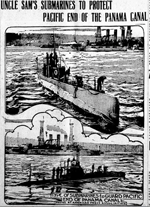 |
2.35k | UNCLE SAM'S SUBMARINES TO PROTECT PACIFIC END OF THE PANAMA CANAL. Washington, December 3. A submarine flotilla, consisting of the vessels C-1 (SS-9), C-2 (SS-13), C-3 (SS-14), C-4 (SS-15), and C-5 (SS-16) has been sent to Colon, to wait until a passage through the Panama canal is opened. Then the submarines will go through to the Pacific entrance of the canal and be permanently station there to guard it. The Atlantic entrance of the canal will be protected from the naval station at Guantanamo, Cuba. | Image and text provided by State Historical Society of North Dakota. Photo from Bismarck Daily Tribune. (Bismarck, Dakota [N.D.]) 1881-1916, 04 December 1913, Image 1, via chroniclingamerica.loc.gov. | |
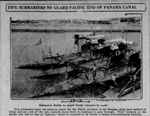 |
567k | SUBMARINES AT COLON FOR DEFENSE OF CANAL Four of the five submarines which, accompanied by a collier and the monitor Montauk, made the record breaking voyage from Guantanamo, Cuba, to Colon, Panama, where they are now anchored at the new concrete docks,waiting to pass through the canal. They will be used in the defense of the Pacific entrance to the canal. This is the first time that submarines have made such a long sea voyage. | Image and text provided by Arizona State Library, Archives and Public Records; Phoenix, AZ Photo from Bisbee Daily Review. (Bisbee, Ariz.) 1901-1971, 04 January 1914, Image 6, via chroniclingamerica.loc.gov. | |
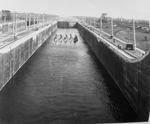 0800932 |
1.30k | Five Submarines in Lower East Chamber, Looking South, 9 March 1914. | National Archives Identifier: 100998702 Agency-Assigned Identifier: 185-G-2067 Photo courtesy of catalog.archives.gov |
|
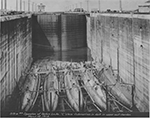 |
1.31k | C boats in Canal, 12 March 1914. From Right to left, C-4 (SS-15), unknown, C-3 (SS-14), unknown & unknown. | National Archives Identifier: 45513793 Local Identifier: 165-WW-338B-050 Photo courtesy of catalog.archives.gov |
|
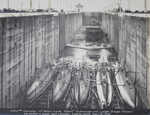 |
940k | Operation of Gatun Locks. Class C submarines and Ladder Dredge Corolzal dry docked in the upper east chamber. Looking North. 6 April 1914. From Left to right: C-1 (SS-9), [#13 on her conning tower]; & C-2 (SS-13), [#15 on her conning tower]. The next 2 boats can't be seen clearly, & the last boat boat on the right is C-4 (SS-15), [#12 on her conning tower]. | Photo by Ernest Hallen, from the digital collection of Ron Armstrong, author of The Panama Canal, the Invisible Wonder of the World Photo i.d. courtesy of Chuck Haberlein, Ric Hedman & David Johnston | |
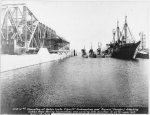 | 53k | C-1 (SS-9); C-2 (SS-13) & C-3 (SS-14) operating at Gatun Locks. C-Class submarines and tender (Severn). Attaching cables from towing locomotives and moving into position to enter upper locks, 14 April 1914. | NARA (National Archives and Record Administration) photo # 19-N-502, courtesy of Daniel Dunham. | |
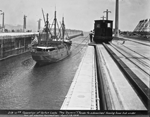 |
1.10k | Operation of the Gatun Locks. (Severn) (tender to the submarines) leaving lower lock under tow of electric locomotives. 15 April 1914. | Photo by Ernest Hallen, from the digital collection of Ron Armstrong, author of The Panama Canal, the Invisible Wonder of the World | |
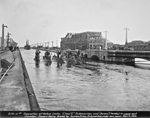 |
884k | Operation of the Gatun Locks. Class C submarines (Severn) (tender) in upper east chamber. (Severn) being towed by locomotives, submarines under own power. 15 April 1914. | Photo by Ernest Hallen, from the digital collection of Ron Armstrong, author of The Panama Canal, the Invisible Wonder of the World | |
 | 868k | C-Class submarines in the Gatun Locks, Panama Canal, circa 1914. The submarines present from Left to right are:C-4 (SS-15),[#12 on her conning tower], C-5 (SS-16), [#14 on her conning tower]; C-3 (SS-14), [no visible number on her conning tower]; C-2 (SS-13), [#15 on her conning tower]; C-1 (SS-9), [#13 on her conning tower]. | Photo i.d. courtesy of Ric Hedman. National Archives Identifier: 45513799 Local Identifier: 165-WW-338B-053. Photo courtesy of catalog.archives.gov | |
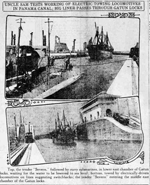 |
785k | UNCLE SAM TESTS WORKING OF ELECTRIC TOWING LOCOMOTIVES IN PANAMA CANAL; BIG LINER PASSES THROUGH GATUN LOCKS Top, the tender (Severn), followed by navy submarines, in lower east chamber of Gatun locks, waiting for the water to be lowered to sea level; bottom, towed by electrically-driven locomotives on lines suggesting switchbacks; the tender (Severn) entering the middle east chamber of the Gatun locks. | Image and text provided by University of Utah, Marriott Library. Photo from The Ogden Standard. (Ogden City, Utah) 1913-1920, 13 June 1914, 4 P.M. City Edition, Image 1, via chroniclingamerica.loc.gov. | |
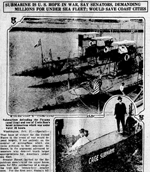 |
2.42k | SUBMARINE IS U. S. HOPE IN WAR, SAY SENATORS, DEMANDING MILLIONS FOR UNDER SEA FLEET; WOULD SAVE COAST CITIES Submarines defending the Panama canal (top) and one of Uncle Sam's latest submarines which was under water 36 hours. | Image and text provided by State Historical Society of North Dakota. Photo from Bismarck Daily Tribune. (Bismarck, Dakota [N.D.]) 1881-1916, 27 February 1915, Image 1, via chroniclingamerica.loc.gov. | |
 | 301k | Scenic port scene showing the Octopus (SS-9), C-2 (SS-13) & C-5 (SS-16) tied up alongside their tender with other vessels. | USN photo courtesy of Scott Koen & ussnewyork.com. | |
 | 105k | The Octopus (SS-9) in dock, location unknown. Note the rotating bow cap, which has exposed the muzzle of her port torpedo tube. | Photo Submarine Force Museum and Library & submitted by Robert Hurst. Text courtesy of U.S. Submarines Through 1945, An Illustrated Design History by Norman Friedman. Naval Institute Press. |
|
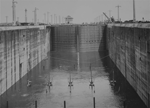 |
824k | Five United States submersibles in the Gatun lock on the Atlantic side of the canal. This photo is of a series that appears in the newspaper article below. | Photo by Ernest Hallen, from the digital collection of Ron Armstrong, author of The Panama Canal, the Invisible Wonder of the World Photo i.d. courtesy of Chuck Haberlein, Ric Hedman & David Johnston | |
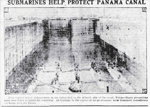 |
489k | SUBMARINES HELP PROTECT CANAL ZONE Five United States submersibles in the Gatun lock on the Atlantic side of the canal. Extraordinary precautions have been taken to guard the waterway. All Germans in the employ of the government were dismissed immediately when we broke with the kaiser. | Image and text provided by Arizona State Library, Archives and Public Records; Phoenix, AZ. Photo from Tombstone Epitaph. (Tombstone, Ariz.) 1887-current, 25 February 1917, WEEKLY EDITION, Image 1, via chroniclingamerica.loc.gov. | |
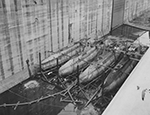 |
1.88k | 4 C boats in Canal, April 1918. From Left to right: C-1 (SS-9), [#13 on her conning tower]; C-2 (SS-13), [#15 on her conning tower]; C-3 (SS-14), [no visible number on her conning tower]; & C-5 (SS-16), [#14 on her conning tower]. | Photographer: Brown & Dawson, NY. National Archives Identifier: 45513769 Local Identifier: 165-WW-338B-38 Photo courtesy of catalog.archives.gov |
|
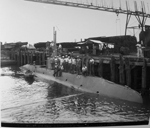 |
511k | C-1 (SS-9) dockside Cristobal C.Z., 1918. | Photo from NARA (National Archives and Record Administration), RG 185-G Vol. 19 # 60 courtesy of Ron Reeves (of blessed memory). | |
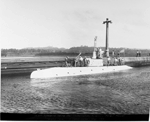 0800926 |
449k | Submarine C-1 (SS-9) taking Mail (subscriptions to Victory Bonds) through Panama Canal in Catun Locks, May 1919. | National Archives Identifier: 100995322 Agency-Assigned Identifier: 26-X13 Photo courtesy of catalog.archives.gov via Ron Reeves (of blessed memory). |
|
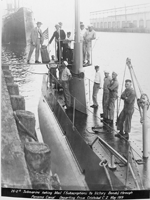 |
781k | C-1 (SS-9) taking mail through Panama Canal, departing from Cristobal C.Z., May 1919. | Photo from NARA (National Archives and Record Administration), RG 185-G Vol. 4 #73 courtesy of Ron Reeves (of blessed memory). | |
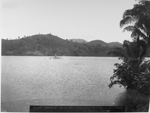 0800931 |
1.12k | Submarine C-1 (SS-9) taking Mail (subscriptions to Victory Bonds) through Panama Canal Gatun Lake near Gamboa May 1919. | National Archives Identifier: 100995322 Agency-Assigned Identifier: 185-G-373 Photo courtesy of catalog.archives.gov |
|
| Back To The Main Photo Index | Back To the Submarine Index |
| Problems and site related matters, E-mail Webmaster |
| This page is created and maintained by Michael Mohl All Pages © 1996 - 2024 NavSource History |